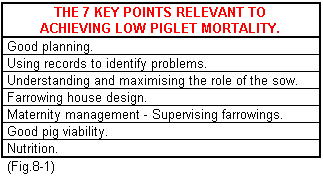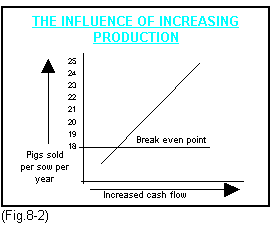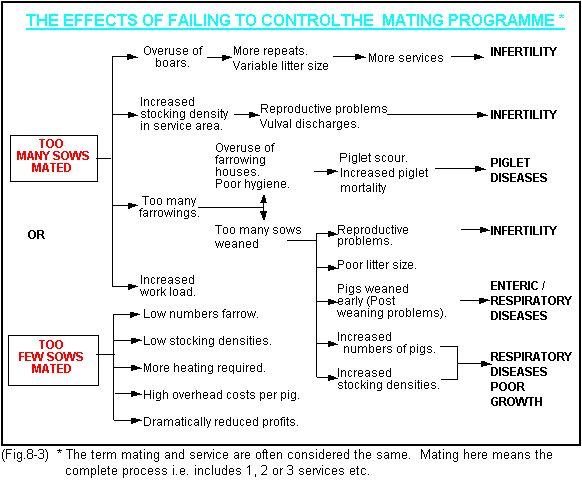



Achieve low pre-weaning mortality
Note: Indoor production unless otherwise stated
An efficient and well managed farrowing house should be able to achieve an average pre-weaning mortality of between 5 and 8%. One objective of this chapter is to discuss those key factors that will achieve such targets. Fig.8-1 identifies the major components of the management system that are relevant to low pre-weaning mortality. A good recording system to identify the problem area or areas of failure is a prerequisite.

Good planning
The planning and control of the mating programme, which ultimately dictates the farrowing programme, are important for disease control because they determine the rate at which pigs move in and out of the farrowing rooms and indeed the whole of the farm. The quality and breeding of the dam and its health status also contribute significantly towards reducing piglet mortality, but the greatest influence arises from management techniques that are adopted around farrowing and during the first 72 hours after birth. A healthy viable piglet with a good birth weight must interact with a good farrowing house environment. Maximising the numbers of piglets reared per breeding female per annum is a major contributing factor to ultimate economic viability of the unit. "Without pigs you can not sell pig meat" is an obvious but little appreciated statement. Fig.8-2 shows the effect on cash flow by increasing the pigs per sow per year from 18 to 25 and most of this economic output will be net profit because the overheads of the unit are not increased by any significant amount.

Pigs sold per sow per year multiplied by the weight of pig leaving the farm determines the kilograms of meat sold per annum and economic output. It is important to maximise this by achieving the maximum biological efficiency of the breeding female on the farm. However over production initiated by too many matings in a given period of time, can have a depressant effect on both health and the efficient use of feed and a study of Fig.8-3 highlights the progression of events that can take place. (See also chapter 3 Management of mating). Note the hidden effects that over use of boars and excessive numbers of matings may have on disease throughout the whole of the production system.








